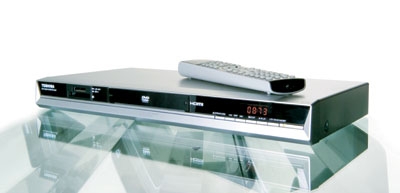DVD + HDMI Page 2

|
Aside from its HDMI output and attractive $150 price, the Toshiba SD-5980 has two unusually versatile features going for it - the two media-card slots on the front panel. Between them they support an impressive array of flash-memory formats, including SD/MMC, xD, and CompactFlash cards as well as Memory Sticks. Not only will the player display slideshows using pictures stored on the cards, but it will also play music stored as MP3 or WMA files. Beyond this, the SD-5980 is pretty much standard-issue and includes such common features as zoom and multiple bookmarks but little else. The remote control was easy to use thanks to its nice, spacious layout.
MUSIC PERFORMANCE The SD-5980 has only analog stereo outputs, so you'll need to use one of its digital audio outputs or the HDMI output to play multichannel Dolby Digital or DTS soundtracks. You'll also want to use a digital connection when playing CDs, since I found the analog output to be noisy. For example, music with a very wide dynamic range - such as practically any Telarc classical or jazz CD - revealed unusually high background hiss.
MOVIE PERFORMANCE Video performance was okay when watching standard interlaced video from the component- and S-video outputs, but when I switched the component-video output to progressive-scan mode, I was disappointed with the results. The resolution of test patterns was obviously softened in the vertical direction, a trait of the Samsung player, too.
To be fair, while this softening was distinct on test patterns, it was tough to see on most of the movies I tried. The eye is amazingly tolerant of loss of detail when a superior picture is not available for side-by-side comparison. But "hard to see" doesn't mean "invisible." In the opening text crawl of Star Wars II: The Attack of the Clones, the tiniest stars in the background either disappeared or were not as bright as they should be. (The Panasonic was the only player in this group to nail that scene.)
Far more common were jagged diagonal edges, a distortion that often occurs when material shot as video has been poorly converted to progressive-scan. These "jaggies" were easily seen on Bruce Springsteen's Live in New York City DVD, on close-ups of the silver metal drum rims and on diagonally slanted mike booms.
With all three players, signals fed to the HDMI output is created in two steps: First the standard-definition interlaced video on the DVD (480i) is converted to standard-def progressive-scan (480p). Then that signal is scaled from 480p to the 720p or 1080i HDTV format.
Viewed over my high-end 720p front projector, images delivered by the Toshiba's 720p HDMI output looked essentially the same as those from its progressive-scan component-video output, jaggies and all. The picture actually improved when I sent 480i component-video signals to the projector, which had a superior progressive-scan conversion circuit.
BOTTOM LINE The card slots are cool, and depending on your TV, the SD-5980's HDMI output might provide modest benefit. But its progressive-scan conversion is less than stellar and affects even the HDMI output. If you're looking to wring every last drop of performance from your DVDs, consider looking elsewhere.





























































